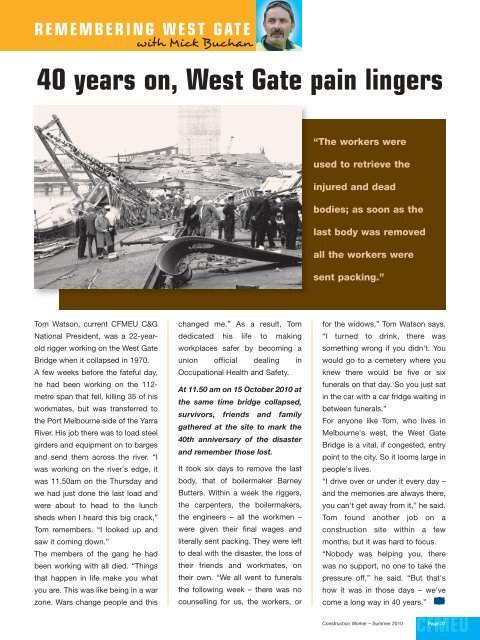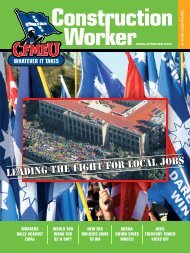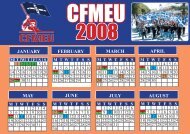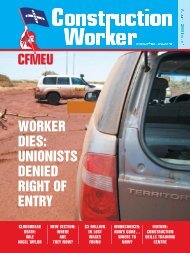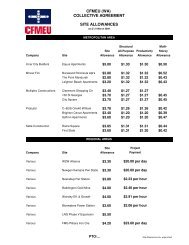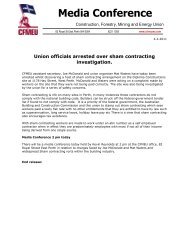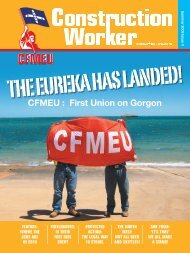Summer Issue 2010 - cfmeu
Summer Issue 2010 - cfmeu
Summer Issue 2010 - cfmeu
You also want an ePaper? Increase the reach of your titles
YUMPU automatically turns print PDFs into web optimized ePapers that Google loves.
REMEMBERING WEST GATE<br />
with Mick Buchan<br />
40 years on, West Gate pain lingers<br />
“The workers were<br />
used to retrieve the<br />
injured and dead<br />
bodies; as soon as the<br />
last body was removed<br />
all the workers were<br />
sent packing.’’<br />
Tom Watson, current CFMEU C&G<br />
National President, was a 22-yearold<br />
rigger working on the West Gate<br />
Bridge when it collapsed in 1970.<br />
A few weeks before the fateful day,<br />
he had been working on the 112-<br />
metre span that fell, killing 35 of his<br />
workmates, but was transferred to<br />
the Port Melbourne side of the Yarra<br />
River. His job there was to load steel<br />
girders and equipment on to barges<br />
and send them across the river. “I<br />
was working on the river's edge, it<br />
was 11.50am on the Thursday and<br />
we had just done the last load and<br />
were about to head to the lunch<br />
sheds when I heard this big crack,”<br />
Tom remembers. “I looked up and<br />
saw it coming down.”<br />
The members of the gang he had<br />
been working with all died. “Things<br />
that happen in life make you what<br />
you are. This was like being in a war<br />
zone. Wars change people and this<br />
changed me.” As a result, Tom<br />
dedicated his life to making<br />
workplaces safer by becoming a<br />
union official dealing in<br />
Occupational Health and Safety.<br />
At 11.50 am on 15 October <strong>2010</strong> at<br />
the same time bridge collapsed,<br />
survivors, friends and family<br />
gathered at the site to mark the<br />
40th anniversary of the disaster<br />
and remember those lost.<br />
It took six days to remove the last<br />
body, that of boilermaker Barney<br />
Butters. Within a week the riggers,<br />
the carpenters, the boilermakers,<br />
the engineers – all the workmen –<br />
were given their final wages and<br />
literally sent packing. They were left<br />
to deal with the disaster, the loss of<br />
their friends and workmates, on<br />
their own. “We all went to funerals<br />
the following week – there was no<br />
counselling for us, the workers, or<br />
for the widows,” Tom Watson says.<br />
“I turned to drink, there was<br />
something wrong if you didn't. You<br />
would go to a cemetery where you<br />
knew there would be five or six<br />
funerals on that day. So you just sat<br />
in the car with a car fridge waiting in<br />
between funerals.”<br />
For anyone like Tom, who lives in<br />
Melbourne's west, the West Gate<br />
Bridge is a vital, if congested, entry<br />
point to the city. So it looms large in<br />
people's lives.<br />
“I drive over or under it every day –<br />
and the memories are always there,<br />
you can't get away from it,” he said.<br />
Tom found another job on a<br />
construction site within a few<br />
months, but it was hard to focus.<br />
“Nobody was helping you, there<br />
was no support, no one to take the<br />
pressure off,” he said. “But that's<br />
how it was in those days – we've<br />
come a long way in 40 years.”<br />
Construction Worker – <strong>Summer</strong> <strong>2010</strong> Page 37<br />
CFMEU


